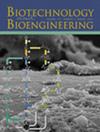A Rational Design Strategy for Engineering CH4 Domain of IgE for Heterodimerization.
IF 3.6
2区 生物学
Q2 BIOTECHNOLOGY & APPLIED MICROBIOLOGY
引用次数: 0
Abstract
The use of bispecific antibodies in cancer immunotherapy is a rapidly expanding domain. Growing relevance of diverse bispecific formats mediating multiple novel mechanisms of action is indicated by the approval of nine bispecific antibodies between 2021 and 2023. Likewise, interest is extending to explore different isotypes of monoclonal antibodies comprising IgA and IgE. Compared to IgG, IgE has been reported to elicit superior antitumour activity in ovarian carcinomas, melanomas, and breast carcinomas. Exploring other isotypes, such as IgE, in a bispecific format may enhance therapeutic applicability and efficacy in the case of solid tumors. However, studies investigating IgE antibodies in bispecific formats are limited due to missing technologies for heterodimerization with only one study providing a proof of concept for the development of bispecific IgE. Our study explored a computational approach for designing heterodimeric IgE antibodies on the basis of the conventional IgG knob-into-hole (KiH) strategy. Furthermore, the resulting novel variant of heterodimeric IgE retained target binding and Fc epsilon receptor engagement, thus providing a proof of concept for future development of therapeutic bispecific IgEs.IgE异源二聚化工程CH4结构域的合理设计策略
双特异性抗体在癌症免疫治疗中的应用是一个迅速发展的领域。2021年至2023年期间批准的9种双特异性抗体表明,多种双特异性形式介导多种新的作用机制的相关性日益增强。同样,研究兴趣正在扩展到探索包含IgA和IgE的不同同种型单克隆抗体。与IgG相比,IgE在卵巢癌、黑色素瘤和乳腺癌中具有更强的抗肿瘤活性。探索双特异性形式的其他同型,如IgE,可能会提高实体瘤的治疗适用性和疗效。然而,由于缺乏异源二聚化技术,研究双特异性IgE抗体的研究受到限制,只有一项研究为双特异性IgE的发展提供了概念证明。我们的研究探索了一种基于传统IgG旋钮入孔(KiH)策略设计异二聚体IgE抗体的计算方法。此外,由此产生的异二聚体IgE的新变体保留了靶标结合和Fc epsilon受体结合,从而为未来治疗性双特异性IgE的开发提供了概念证明。
本文章由计算机程序翻译,如有差异,请以英文原文为准。
求助全文
约1分钟内获得全文
求助全文
来源期刊

Biotechnology and Bioengineering
工程技术-生物工程与应用微生物
CiteScore
7.90
自引率
5.30%
发文量
280
审稿时长
2.1 months
期刊介绍:
Biotechnology & Bioengineering publishes Perspectives, Articles, Reviews, Mini-Reviews, and Communications to the Editor that embrace all aspects of biotechnology. These include:
-Enzyme systems and their applications, including enzyme reactors, purification, and applied aspects of protein engineering
-Animal-cell biotechnology, including media development
-Applied aspects of cellular physiology, metabolism, and energetics
-Biocatalysis and applied enzymology, including enzyme reactors, protein engineering, and nanobiotechnology
-Biothermodynamics
-Biofuels, including biomass and renewable resource engineering
-Biomaterials, including delivery systems and materials for tissue engineering
-Bioprocess engineering, including kinetics and modeling of biological systems, transport phenomena in bioreactors, bioreactor design, monitoring, and control
-Biosensors and instrumentation
-Computational and systems biology, including bioinformatics and genomic/proteomic studies
-Environmental biotechnology, including biofilms, algal systems, and bioremediation
-Metabolic and cellular engineering
-Plant-cell biotechnology
-Spectroscopic and other analytical techniques for biotechnological applications
-Synthetic biology
-Tissue engineering, stem-cell bioengineering, regenerative medicine, gene therapy and delivery systems
The editors will consider papers for publication based on novelty, their immediate or future impact on biotechnological processes, and their contribution to the advancement of biochemical engineering science. Submission of papers dealing with routine aspects of bioprocessing, description of established equipment, and routine applications of established methodologies (e.g., control strategies, modeling, experimental methods) is discouraged. Theoretical papers will be judged based on the novelty of the approach and their potential impact, or on their novel capability to predict and elucidate experimental observations.
 求助内容:
求助内容: 应助结果提醒方式:
应助结果提醒方式:


